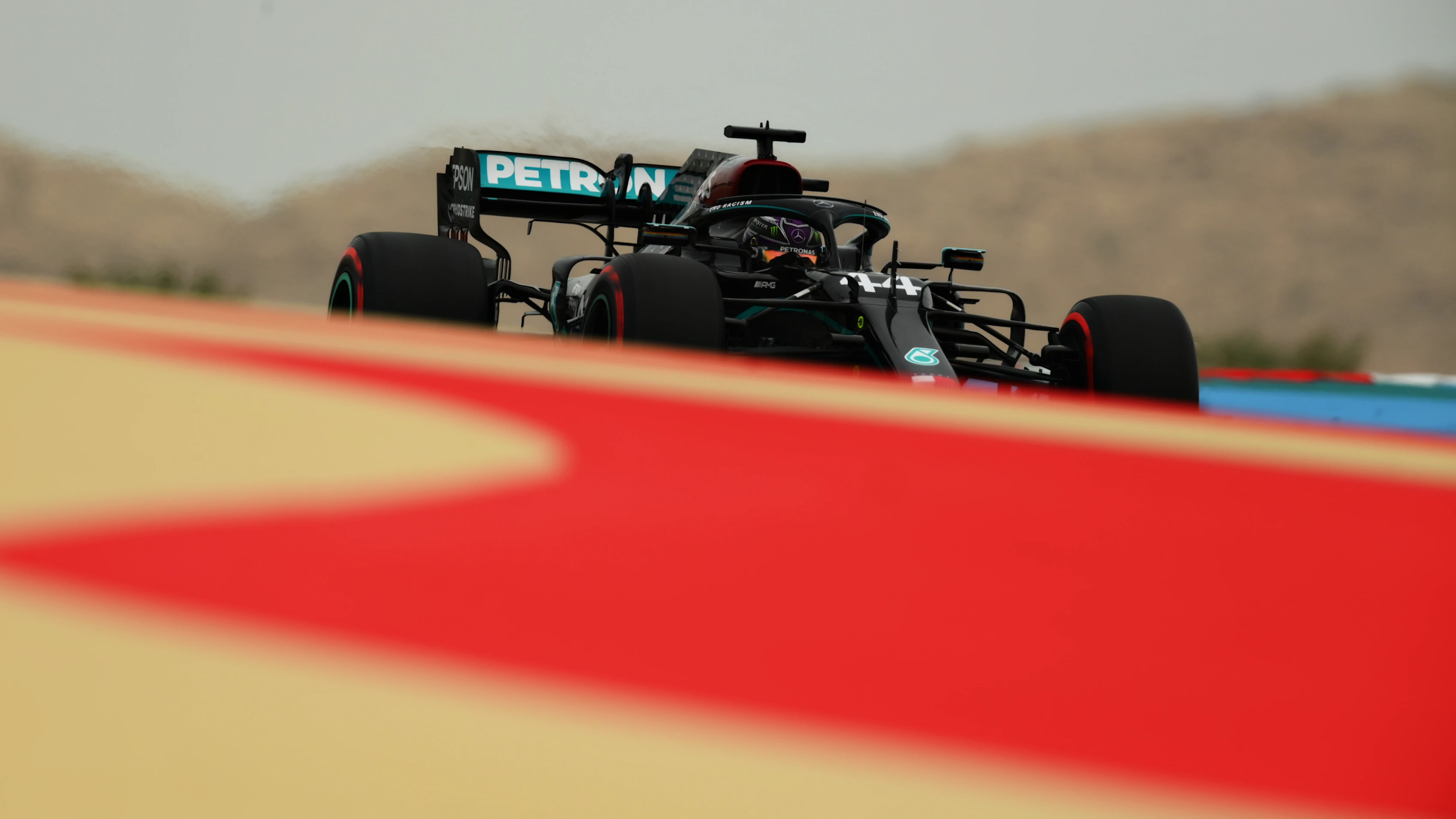After a relatively short winter break, the drivers and teams are back to it, as they prepare for 2021 Aramco Pre-Season Testing on March 12-14 – ahead of what’s set to be the longest season in Formula 1’s history. So, with the 2021 cars getting ready to be run in anger for the first time, let’s look at everything you need to know ahead of pre-season testing this year, including who’s driving, how long they’ll have behind the wheel, and why testing is still so vital for the teams.
Where is testing taking place this year?
Pre-season testing 2021 will be taking place at the Bahrain International Circuit. F1 has, in recent years, tested at the Circuit de Barcelona-Catalunya in Spain. But with the calendar having been moved around – and with the Bahrain Grand Prix on March 28 now set to kick off the season – the decision was taken to hold testing at that venue too.
READ MORE: Formula 1 confirms Portuguese Grand Prix will take place on May 2 calendar slot
How many days of pre-season testing are there in 2021?
The drivers and teams have just three days to put their cars through their paces at Bahrain this year – making it a tall order in particular for F1’s fresh intake of rookies, as well as for drivers like Daniel Ricciardo, Carlos Sainz and Sergio Perez who've switched teams over the winter.
The three days of pre-season testing in 2021 is down from six days in 2020, and eight in 2019 – and it’s not even three days per driver either, with teams allowed to run just one car on track, meaning most drivers will get a maximum of 1.5 days each.

Why are teams testing this year if their chassis are the same as last year?
It is true that, due to the impact of coronavirus, teams have been ordered to reuse their 2020 chassis in 2021.
But with a change to the technical regulations designed to reduce downforce levels, new Pirelli compounds to comprehend, as well as the reasonable amount of aerodynamic and power unit changes that the teams were permitted to make over the winter, the 2021 cars will have moved on a step since last year – and will need to be understood as best as possible before the season proper gets underway on March 28.
While McLaren have a whole new power unit supplier to contend with, having switched from Renault to Mercedes for this year.
READ MORE: Mercedes show off new W12 car – but what are they hiding, and why?
Why do teams still need to test at all?
While some drivers would probably be happy doing away with testing completely, for teams, it’s an essential part of their preparation for the season ahead.
Systems checks need to be carried out, while aerodynamic data needs to be gathered and correlated to figures gained in wind tunnel and CFD [Computational Fluid Dynamics] simulations – a process done on track using tools like aero rakes and flo-vis paint.
There are also new mechanical parts – as in the case of Mercedes’ revelatory DAS system last year – that need to be tried out in the wild, while quite simply, pre-season testing is a chance for teams to try and iron out as many bugs and reliability issues as they can before the first race of the year.

The drivers, too, benefit, with testing giving them a chance to blow the winter cobwebs off and get their bodies – and especially their necks – in the zone ahead of the first race of the season. For the mechanics, meanwhile, pre-season testing is also an opportunity to practise pit stops, as well as rehearse working on their new machines outside of the pressure cooker environment of a race weekend.
READ MORE: Aramco Pre-Season Testing – 5 ways testing in Bahrain will be different to Barcelona
Who are the main drivers and teams to look out for in 2021?
All eyes will naturally be trained on reigning seven-time champions Mercedes who, among other things, have admitted that they’re yet to reveal the proper floor of their W12 challenger – while their chief rivals from last year Red Bull, now with Sergio Perez in situ, have also been very secretive about the RB16B coming into testing, suggesting they may have something up their sleeve too.
WATCH: 5 key questions from the launch of Red Bull's RB16B 2021 car
Fresh entities in Aston Martin and Alpine – with new faces Sebastian Vettel and Fernando Alonso respectively at their wheels – will be worth watching too, while it will be interesting to see where McLaren stack up with their new Mercedes engines.
Can Ferrari’s own all-new power unit, meanwhile, allow drivers Carlos Sainz and Charles Leclerc to close the gap to the front of the pack this year – and give a helping hand to Ferrari’s customer teams Haas and Alfa Romeo as well? And while we’re on Haas, be sure to look out for their two rookie drivers Nikita Mazepin and Mick Schumacher in action, along with AlphaTauri’s Yuki Tsunoda – while Williams will also be running their Test Driver Roy Nissany on one day of testing.

Does the order in testing dictate the order for the rest of the season?
Sort of. Pre-season testing certainly gives a flavour of who’s hot and who’s not, as well as exposing reliability concerns for teams.
It’s also true that Mercedes topped the times comfortably last year, with Max Verstappen putting Red Bull a distant second – a result then played out in the season’s constructors’ standings – while Ferrari’s lukewarm Barcelona test in 2020 was subsequently followed up by their worst season since 1980.
READ MORE: Data suggests Ferrari have 'recovered quite a lot of speed on the straights' says Binotto
But pre-season testing can create false impressions, too – and with fuel loads, engine maps and so on all kept under lock and key by the teams, the picture created by testing can sometimes be misleading.
Is there a maximum number of laps?
There is not! Drivers are free to lap to their hearts’ content, barring any stoppages for red flags, breakdowns and such of course.
Timing-wise in 2021, the Bahrain track will go green at 1000 local time each day until 1400. There’s then an enforced hour-long lunch pause, before the action gets going again from 1500 to 1900 – with the day then topped off with media interviews, engineering debriefs and some sorely-needed physio sessions for the drivers.
READ MORE: Albon says he's 'ready to take anyone's space' as he stays sharp on reserve duty

Do the teams and drivers have to attend?
They do not. There’s no penalty for teams for missing pre-season testing if they so choose. But with on-track running so limited these days, a team not turning up at testing usually means that something fairly undesirable has gone on behind the scenes, such as when Williams missed the first two days of running in 2019 due to their FW42 not being ready in time.
Assuming the teams do turn up, meanwhile, it’s worth noting that they are then obliged to keep their garages open and their cars uncovered, unless either the floor has been taken off, or the car is being recovered back to the pits after stopping out on track.
Where can I watch 2021 F1 testing?
We’ll be providing full coverage of 2021 pre-season testing from Bahrain live for F1 TV Pro subscribers – while Sky F1 viewers in the UK, Germany and Italy, plus DAZN F1 viewers in Spain and DAZN viewers in Japan, will also be able to tune into live coverage of the tests at the Bahrain International Circuit. Elsewhere, other local F1 broadcasters will, of course, also feature additional news and highlights.
Live coverage will run from 0650 to 1105 UTC (for the morning session) and then again from 1155 to 1610 UTC (for the afternoon session) each day, from March 12-14.
You can also stay up-to-date with the action via live timing, as well as our live blog right here on F1.com.
Head to F1 TV to subscribe now and for a limited period enjoy 25% off a one-year subscription with the code F1TV25
Next Up
Related Articles
 ExclusiveHow APXGP was brought to life by costume designer Julian Day
ExclusiveHow APXGP was brought to life by costume designer Julian Day Leclerc calls Ferrari’s focus shift to 2026 a ‘no-brainer’
Leclerc calls Ferrari’s focus shift to 2026 a ‘no-brainer’ Celebrating the first F1 Allwyn Global Community Awards
Celebrating the first F1 Allwyn Global Community Awards EXPLAINED: The key terms for F1’s new-for-2026 rules
EXPLAINED: The key terms for F1’s new-for-2026 rules F1 AcademyHaas name Countryman as 2026 F1 ACADEMY driver
F1 AcademyHaas name Countryman as 2026 F1 ACADEMY driver 3 inspiring individuals share their paths to working in F1
3 inspiring individuals share their paths to working in F1

